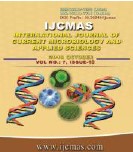


 National Academy of Agricultural Sciences (NAAS)
National Academy of Agricultural Sciences (NAAS)

|
PRINT ISSN : 2319-7692
Online ISSN : 2319-7706 Issues : 12 per year Publisher : Excellent Publishers Email : editorijcmas@gmail.com / submit@ijcmas.com Editor-in-chief: Dr.M.Prakash Index Copernicus ICV 2018: 95.39 NAAS RATING 2020: 5.38 |
Gladiolus (Gladiolus hybrida L.) has been found as a potential cut flower cultivated world widely due to its attractive spikes and elegancy. The plant is propagated vegetatively through corms and cormels but more often its cultivation is hindered due to low multiplication rate of its corm and cormels. Gladiolus can grows through underground stems also, but it is more oftenly attacked by soil borne diseases. In vitro propagation techniques, assumes significance, especially for securing rapid multiplication of the novel cultivars using different explants sources and media. The in vitro regeneration of gladiolus cultivar White prosperity was achieved using shoot bud of cormels as an explant. The concentration and combination of plant growth regulators governed the regenerative capacity of explants. The BAP efficiently produced multiple shoots in gladiolus on B5 and MS media. The number of shoots varied from 1.3 to 3.0 shoots per explant on B5 media and 0.6 to 2.3 shoots per explant on MS media. After 30 days of incubation, the length of in vitro developed multiple shoots varied from 2.2 to 3.8cm in B5 media and 1.1 to 2.9cm in MS media. Also a monomorphic banding profile was obtained using Randomly Amplified Polymorphic DNA (RAPD) markers indicating that there was no genetic variation in in-vitro raised plants with respect to the mother plant when in-vitro regeneration was carried out. Hence, in vitro regeneration could be suggested for more efficient and cost effective mass propagation of Gladiolus.
 |
 |
 |
 |
 |